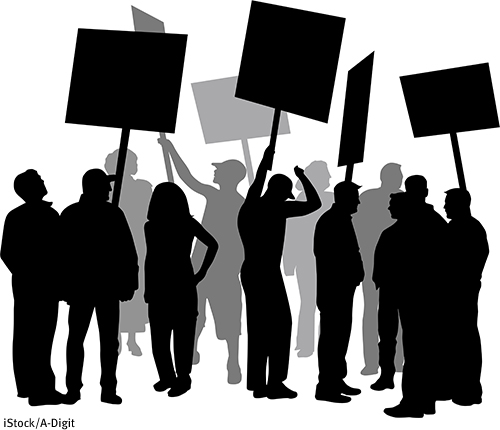Transit workers and riders, unite!
Saving public transit requires teamwork
December 3, 2014
by Amy B. Dean - @amybdean Link to Article
Battles over public transit are heating up, and they may be coming soon to your hometown.
U.S. cities are facing tight budgets in maintaining their networks of buses, trains and light rail. As with other publicly funded services, such as education, city managers and elected officials are trying to scapegoat public employees rather than fight to secure the resources needed to protect both quality public service and living-wage jobs.
Many such allegations are being made in advance of labor negotiations. In Houston and Chicago, labor contracts for bus drivers are set to expire next year. A raft of smaller cities will also face new contract negotiations. Commuters may be looking warily at these labor negotiations as a potential inconvenience to their daily transit routines. Municipal managers often try to oppose commuters’ demand for reliable, quality service in the name of benefits to transit workers. In Portland, Oregon, for example, TriMet, which provides bus, light rail and commuter rail service for the metro area, faced a projected budget shortfall of $17 million. TriMet is blaming a large percentage of the deficit on a convenient scapegoat: supposedly unsustainable health care costs for union employees.
This is nothing more than a divide and conquer tactic. Over the last decade, the transit-justice movement has brought together drivers and riders to protect public transit and improve services in underfunded communities. But the loose alliances have largely remained tentative. Public transit is a crucial issue of social justice that draws together labor, environmental, civil rights and economic concerns. In the face of expiring contracts and limited city budgets, transportation workers’ unions and public transit commuters’ groups should build on and strengthen those partnerships and resist efforts to drive a wedge between them. Quality service for all of us who ride public buses and trains may depend on it.
Riders’ unions
Over the last two decades, transit riders in cities across the country have been pressing local and state governments for fairer service and more reliable funding. For example, the Bus Riders Union in Los Angeles has successfully fought fare increases and won legal settlements against the transit authority’s discriminatory servicing of Latino, African-American and Asian neighborhoods. Similarly, the T Riders Union in Boston has been lobbying for raising the gas tax to increase revenue for mass transit and reduce citywide carbon emissions. In New York City, the Straphangers Campaign, one of the city’s many rider advocacy groups, has fought to save riders from steep fare increases and severe service cuts.
In other cases, commuter groups have taken the lead in addressing issues that affect riders and transit workers. In Salt Lake City, the Utah Transit Authority came under fire recently from the state government and local commuters. In August an official audit criticized the authority for budgeting outsize executive salaries while leaving infrastructure projects unfunded. The authority also cut late-night hours, infuriating bus riders who work irregular shifts.
“Imagine if you are coming off a 12-hour shift at 9:30 p.m. and rushing to catch your bus home,” one resident told the local Fox affiliate, “only to see it pull away just before you got to your stop. Now that’s the last bus, you can’t afford a taxi, and you don’t have a car. So what do you do? You walk an hour home.” By the end of August, more than 3,000 riders had signed a petition, supported by the Utah Transit Riders Union, to restore late-night service — a move that would also benefit drivers whose working hours were reduced.
“If we want to protect living-wage jobs and reliable transportation service, we should reject efforts to put riders and drivers at odds and instead recognize our common cause.”
Transit workers’ unions must not advocate merely for their members. Instead, they must champion public concerns on transportation issues. And if they are serious about preserving and improving the system, they should not wait until contract negotiations start to reach out to riders for support.
In recent years, some union members have helped lead or bolster community-based campaigns. In New York City, for example, bus drivers responded to the Metropolitan Transportation Authority’s route reductions by rallying residents affected by the cuts. The Transportation Workers Union drivers identified a bus line notorious for overcrowding and long waits and collected signatures at each stop for a petition calling for more buses. The union conducted outreach to several neighborhood groups in one of the working-class communities that depended on the line. By opening a dialogue with the local housing project’s tenant association, a youth development organization and other civic associations, the union was able to mobilize community support for a successful push to restore funding for the affected line.
These are but some examples of communities coming together to reject the scapegoating of public employees as a way to avoid strengthening our transit systems. By articulating how the interests of diverse groups are intertwined, the organizers are making a persuasive case for public transportation as a vital civic good.
Toward transit justice
Over the past decade, advocates working on public transportation issues from a range of constituencies — labor, environmental organizations, commuter groups, racial justice advocates — have come to recognize that they have common ground. Rather than approaching the issue as separate interest groups, they are starting to see themselves as part of a unified transit-justice movement.
These groups have highlighted the importance of quality public transit for their respective memberships. First, transportation is an essential part of the family budget for most Americans. For families with one or more cars, transportation accounts for more than any other spending category except housing. In times when wages are stagnant, many people rely on affordable public transportation as a means to get to work and run errands for their families. “Over the past decade, housing and transportation costs in the Bay Area have increased, while average income has not,” the Alameda County Public Health Department said in a recent report. “Surveyed riders report having to make difficult budget trade-offs when they don’t have enough money to cover monthly expenses.”
Also, public transportation is not merely a matter of economic justice for riders. As an alternative to our fossil-fuel-intensive car culture, it has important consequences for the environment. Transit is a source of jobs — in construction of infrastructure and in provision of service. A healthy U.S. economy cannot be sustained by poverty-level employment. It is important that working-class Americans are able to earn a living wage and contribute to their communities.
Finally, transit has regularly become a matter of civil rights. Communities of color are often neglected in city planners’ designs. And minority communities that are often the most negatively affected when municipalities consider service cuts or debate where new transit lines should go.
Alliances between transportation unions and riders’ groups are central to a transit justice framework. And they are becoming increasingly important to the future of our cities. If we want to protect living-wage jobs and reliable transportation service, we should reject efforts to put riders and drivers at odds and instead recognize our common cause.
Amy B. Dean is a fellow of the Century Foundation and a principal of ABD Ventures, a consulting firm that works to develop innovative strategies for organizations devoted to social change. She is a co-author, with David Reynolds, of “A New New Deal: How Regional Activism Will Reshape the American Labor Movement.”
“Imagine if you are coming off a 12-hour shift at 9:30 p.m. and rushing to catch your bus home,” one resident said, “only to see it pull away just before you got to your stop. Now that’s the last bus, you can’t afford a taxi, and you don’t have a car. So what do you do? You walk an hour home.”
Increased Demands for Transit Justice
Service
Fares


